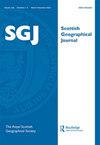作为突破口:感受气候变化的热度
IF 2
4区 社会学
Q2 GEOGRAPHY
引用次数: 1
摘要
摘要极端高温事件可能性的增加是我们全球气候紧急情况的一个极其重要的方面,但天气和气候之间的联系仍然是一个难以沟通的话题。在这里,我关注的是一个正在成为病毒的图形:温暖的条纹。暖带使用一个简单的双色光谱调色板——蓝色和红色,这是天气图的一个长期特征——来表示相对的年温度。避开了这种色调具有普遍情感能力的论点,并反思了其设计师关于可能引入一种新颜色紫色来表示酷热的评论,我认为,正是由于温度和颜色之间的一种构建的、习得的联系,这种视觉才有可能进一步发出警告。也就是说,虽然紫色的潜在引入标志着对习惯气候条件的突破,但也被突破的是我们保持捕捉这些条件的测量标准的能力。我通过引用这种突破的先例来扩展这一论点,因为预测的热浪促使澳大利亚气象局在其温度等级的高温端引入了一种新的颜色:紫色。本文章由计算机程序翻译,如有差异,请以英文原文为准。
In the breach: feeling the heat of climate change
ABSTRACT The increased likelihood of extreme heat events is a profoundly important aspect of our global climate emergency, and yet the link between weather and climate remains a difficult subject to communicate. Here, I focus on a graphic that is on its way to becoming viral: Warming Stripes. Warming Stripes use a simple two-colour spectral palette – tints of blue and red, long a feature of weather maps – to signal relative yearly temperatures. Eschewing the argument that such hues have a universal affective capacity, and reflecting on its designer’s comments on the potential introduction of a new colour, purple, to indicate extreme heat, I argue that it is as a constructed, learned association between temperature and colour that there is further potential for this visual to intimate a warning. That is, while the potential introduction of purple signals a breach regarding accustomed climatic conditions, what is also breached is our capacity to maintain a standard of measurement by which to capture such conditions. I expand on this argument via reference to a prior of just such a breach, as a forecasted heatwave prompted the Australian Bureau of Meteorology to introduce a new colour to the hot end of its temperature scale: purple.
求助全文
通过发布文献求助,成功后即可免费获取论文全文。
去求助
来源期刊

Scottish Geographical Journal
GEOGRAPHY-
CiteScore
1.80
自引率
20.00%
发文量
19
期刊介绍:
The Scottish Geographical Journal is the learned publication of the Royal Scottish Geographical Society and is a continuation of the Scottish Geographical Magazine, first published in 1885. The Journal was relaunched in its present format in 1999. The Journal is international in outlook and publishes scholarly articles of original research from any branch of geography and on any part of the world, while at the same time maintaining a distinctive interest in and concern with issues relating to Scotland. “The Scottish Geographical Journal mixes physical and human geography in a way that no other international journal does. It deploys a long heritage of geography in Scotland to address the most pressing issues of today."
 求助内容:
求助内容: 应助结果提醒方式:
应助结果提醒方式:


